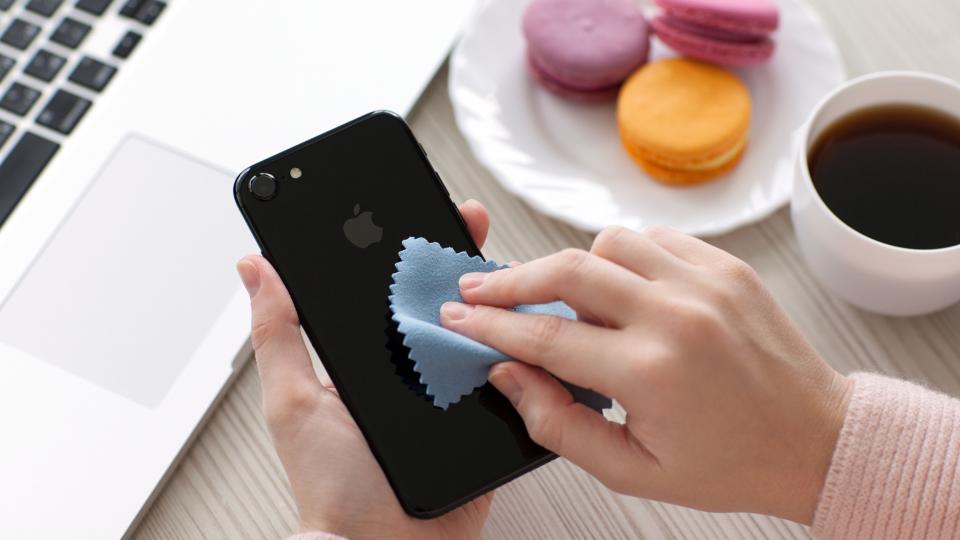To help us provide you with free impartial advice, we may earn a commission if you buy through links on our site. Learn more

It comes as no surprise to learn that smartphones aren’t exactly the cleanest things in the world. Some studies have even suggested that our mobiles carry 10 times more bacteria than most toilet seats.
Considering just how attached we are to our phones (touching them 2617 times a day on average) it’s probably a good idea to clean them from time to time. But what’s the best way to do this? Fret not: we’ve done the research so you don’t have to.
Before we begin, a word of warning: following anything besides the manufacturers’ advice for cleaning your phone – which we include below – may void the warranty and potentially damage your phone. As such, we remind you that you try any other methods at your own risk.
Update: In response to the coronavirus (COVID-19) pandemic
With growing concerns about the recent coronavirus outbreak, people have been paying unprecedented attention to issues of personal hygiene – things such as hand washing, keeping surfaces clean, and even disinfecting smartphones have taken on a new importance.
While the ultimate advice at this point is to simply stay at home, medical experts have recommended cleaning your phone “at least once a day” to prevent the spread of the virus. After all, our smartphones are basically extensions of our hands.
Companies have also been responding to these concerns. Apple, for example, recently updated their iPhone cleaning guidelines. Having previously warned against the use of harsh chemicals on your phone’s screen, new advice states that “using a 70 per cent isopropyl alcohol wipe or Clorox Disinfecting Wipes, you may gently wipe the exterior surfaces of your iPhone”. But stay away from bleach, avoid getting any moisture in your phone’s openings, and don’t submerge your phone in any cleaning agents.
Despite this, the advice in this article remains largely the same: warm soapy water is still one of the best remedies for a potentially virus-ridden phone. And this advice has been corroborated by the likes of Dr Lena Ciric, a microbiologist at University College London. That said, read on for our guide on how to clean your smartphone…
How to clean your smartphone: What the manufacturers say
According to Apple, the best way to clean your iPhone is to use a soft, slightly damp lint-free microfibre cloth. If this doesn’t do the trick, dampen the cloth with warm soapy water (without applying water directly to the phone).
Be warned, however, that these guidelines differ between generations of iPhone, so avoid using soap on anything older than an iPhone 11. Also avoid applying cleansing products such as antibacterial wipes to your iPhone screen as this will degrade the oleophobic coating, and always be careful around openings in the phone such the charging port.
Similarly, Samsung suggests using a damp cloth on phones such as the Galaxy Note 8, and warns against any cleaning solutions. For Google’s Pixel phones, however, using cleaning wipes or household soap when needed is fine, although a dry or damp cloth should suffice in most circumstances.
Simple, but is it enough? A 2013 study in the American Journal of Infection Control showed that using a damp microfibre cloth proved just as effective as bleach wipes or alcohol swabs in removing MRSA from a contaminated hospital iPad. Although reassuring, this is no reason to become complacent. Just because a damp cloth can remove MRSA from a medical staff iPad, it doesn’t necessarily mean it will reliably and consistently rid your phone of flu or everyday germs.
READ NEXT: The best smartphones you can buy today

How to clean your phone: Is there anything else I can try?
According to some sources, there are a number of other methods you can adopt to clean your phone, such as using a diluted mix of water and rubbing alcohol or white vinegar. As before, use a soft, lint-free cloth rather than applying the solution directly to your phone. Again, be aware that some chemicals can damage the oleophobic coating on your phone’s screen.
Lenswipes, commonly used on glasses or cameras to remove smudges, have also been recommended for use on smartphone screens.
If you’re really serious about hygiene, you can even purchase a UV phone sanitiser. Imagine a mini tanning bed, but for your phone. Although these things claim to kill 99.9% of bacteria with UV light, we have no proof of this. And furthermore, we haven’t tested these methods ourselves, so we can’t guarantee that they actually work.
READ NEXT: Everything we know about the OnePlus 8
How to clean your phone: Final take
There’s a whole load of advice out there on how to clean or disinfect your phone, and while many of these methods might work, it’s good to take this advice with a pinch of salt.
The safest method is perhaps the simplest; use a damp cloth – with warm soapy water where applicable – and avoid the use of any harsh chemicals that could damage your phone.




